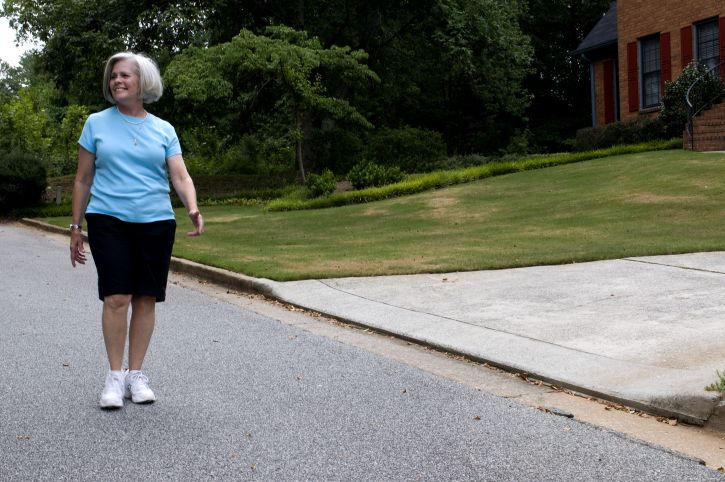Walking Our Way to Better Health
We are spending 2.8 trillion dollars each year in the United States on health care—far more than any other country in the world.
Interestingly, more than 75 percent of that sum is going toward chronic diseases. Chronic conditions can actually be prevented.
Chronic diseases have two main behavioral causes—unhealthy eating and unhealthy inactivity. Knowing that to be true, what opportunities do we have to make behavioral changes that can actually improve health? The good news is we can remedy inactivity fairly easily.
When you look at all of the options available for improving health, the analysis points to one behavioral change that has both the highest potential to have an impact and the highest potential to actually be done by people. That high-impact, high-potential behavior is—very simply—walking.
The human body is made to walk—and we do not walk enough in America today.
Seventy percent of us in the most prosperous country on earth are completely inactive. That inactivity is making us sick, shortening our lives, and robbing our quality of life. Inactivity is a national epidemic, and it is literally killing us. Walking works. We can improve our individual and collective health, transform and lengthen our lives, and slash our medical and business costs if we walk regularly.
Our bodies are made to walk. Walking gets our blood flowing and increases the percentage of good cholesterol (HDL) in our bodies. Walking teaches our bodies to use sugar more efficiently, thus reducing diabetes risks. Walking releases chemicals in our brains that make us feel good.
At Kaiser Permanente (KP), we consider physical activity to be a crucial vital sign for our 8.8 million members. We now record activity levels in our electronic health records. We have walking programs for our employees and our patients. We sponsor educational walking websites and cell phone apps. Our physicians write our patients prescriptions for exercise, most commonly for walking.
We don’t need to walk a lot. Thirty minutes a day. Five days a week. That’s how much moderate, regular walking can prevent and treat chronic, potentially deadly conditions. Some of the proven benefits of walking include:
- Walking 30 minutes a day cuts the rate of developing diabetes by more than half. [1]
- Walking can cut the risk of stroke by more than 25 percent. [2]
- Walking cuts the risk of certain cancers and could save 10,000 lives a year. [3]
- People who walk are less likely to catch a cold and catch fewer colds. [4]
- Walking helps prevent and treat depression with as much as an 82 percent success rate. [5]
Walking can be powerful medicine. It only takes 30 minutes a day—or 15 minutes twice a day—5 days a week—to get wonderful results.
Kaiser Permanente believes so strongly that America needs to get walking right now that we are powering an online walking hub at www.everybodywalk.org. Walking is the right thing to do and an easy thing to do. At Kaiser Permanente, we strive to Make the Right Thing Easy To Do. We suggest that people:
- Schedule a “walking meeting” during your workday.
- Walk with colleagues during your lunch break.
- Invite others for a walk before work. At many KP medical centers, our physicians host “Walk with Your Doc” events throughout the week.
- Park in an area so that it takes at least 15 minutes to walk to work, then walk 15 minutes back to your car at the end of the day.
The benefits of walking are not limited to our physical health. Walking through neighborhoods and cities lets you experience your environment in ways not possible when driving in a car. Walking has given me, personally, the gift of my town and has changed my life in powerful, positive ways.
We can reduce chronic disease significantly by just getting on our feet. It would be almost criminal and definitely unhealthy not to walk.
Every. Body. Walk!
References
- Diabetes Prevention Program Research Group. 2002. Reduction in the incidence of type 2 diabetes with lifestyle intervention or metformin. New England Journal of Medicine 346:393-403. https://doi.org/10.1056/NEJMoa012512
- Hooker, S. P., X. Sui, N. Colabianchi, J. Vena, J. Laditka, M. J. LaMonte, S. N. Blair. 2008. Cardiorespiratory fitness as a predictor of fatal and nonfatal stroke in asymptomatic women and men. Stroke 39(11):2950-2957. https://doi.org/10.1161/STROKEAHA.107.495275.
- World Cancer Research Fund and American Institute for Cancer Research. Food, nutrition, physical activity, and the prevention of cancer: A global perspective. Washington, DC: AICR, 2007.
- Nieman, D. C., D. A. Henson, M. D. Austin, and V. A. Brown. 2005. Immune response to a 30-minute walk. Medicine and Science in Sports and Exercise 37(1):57-62. https://doi.org/10.1249/01.mss.0000149808.38194.21
- Blumenthal, J. A., M. A. Babyak, K. A. Moore, W. E. Craighead, S. Herman, P. Khatri, R. Waugh, M. A. Napolitano, L. M. Forman, M. Appelbaum, P. M. Doraiswamy, and K. R. Krishnan. 1999. Effects of exercise training on older patients with major depression. JAMA Internal Medicine 159(19):2349-2356. https://doi.org/10.1001/archinte.159.19.2349

